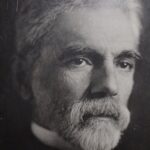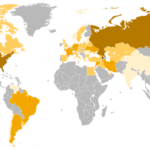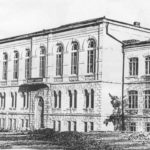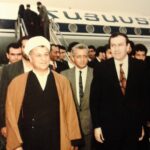WikiLeaks – Armenia No 35
C O N F I D E N T I A L SECTION 01 OF 03 YEREVAN 001492
SUBJECT: LINES OF CONTACT–NEW GOAM TEAM TACKLING TURKEY ISSUE
Classified By: DCM A.F. Godfrey for reasons 1.4 (b,d).
——-
SUMMARY
——-
¶1. (C) Beyond the attention-grabbing meetings between GOAM [Government of Armenia] Deputy Foreign Minister Arman Kirakossian and Turkish MFA Deputy Undersecretary Ahmet Uzumcu (septel), the Armenians point to a series of government-to-government channels that provide opportunities for exchange with their estranged neighbor. These mid and low-level contacts are admittedly limited in their ability to influence the top policy makers. Post believes, however, that they are important confidence building measures and will lay the bureaucratic foundation for real exchange once relations are established. Recent staffing changes in the Armenian MFA created a new set of Armenian bureaucrats handling the Turkey account. The five key actors, and their roles in the Turkey-Armenia rapprochment process, are part of a cadre of younger, western-educated Turkey scholars in the GOAM who are upbeat about the prospects for the bilateral relationship. Although immediate prospects for Armenia-Turkey relations appear slim, we continue to reach out to this set of GOAM bureaucrats to underscore USG [U. S. Government] policy on the issue. End Summary.
——————————————–
DEPUTY MINISTERS MAKE HEADLINES, OFFER COVER
——————————————–
¶2. (C) While Foreign Minister Oskanian is still the principal author of Turkey policy in the GOAM, the main point of contact between the Governments of Armenia and Turkey remains the relatively quiet, somewhat regular meetings at the Deputy Minister level. Deputy Foreign Minister Arman Kirakossian has followed in the tradition of his predecessor and has already met twice in Vienna with his Turkish counterpart (septel). The most recent meeting appears to have done little more than bring the talks back to the point where they left off before the Armenians declared 2005 a “Genocide Anniversary Year,” but remains the most substantive talks that follow a regular schedule.
¶3. (C) Kirakossian, formerly Armenia’s Ambassador in Washington (1999-2005), has told us he enjoys his assignment to follow Turkish relations. He studied Turkish as an undergraduate and still reads Turkish (although his speaking abilities are limited). His publications on the events of 1914-1915 (mostly studies of foreign governments’ reactions at the time and compendia of supporting documents), at first raised questions as to whether or not the Turks would consider him a reasonable interlocutor in the process. A former MFA employee has told us, however, that Kirakossian has mellowed his stance toward Turkey and is exploiting his “harmless, teddy bear” image to endear the Turks and make headway on some of the toughest issues. Conversely, MFA colleagues called former Deputy Minster Ruben Shugarian, now Armenia’s Ambassador to Rome, “the shrewd lawyer” (when he covered Turkey issues) and hoped that he could out maneuver the Turks to get them to drop their insistence that Armenia recognize Turkey’s border. Comment: The meetings of the Deputy Foreign Ministers provide a valuable exchange of information and much needed contact between the two governments. However, meetings at this level also offer Minister Oskanian and President Kocharian a measure of political cover so that they can tackle issues that nationalist forces within the GOAM prefer they not even raise with the Turks. End comment.
——————————————— —-
MFA MIDDLE EAST DEPARTMENT HOUSES TURKISH EXPERTS
——————————————— —-
¶4. (C) Routine diplomatic work on the Turkey-Armenia relationship passes through the MFA’s Middle East Department. The department, previously headed by rising MFA star Karen Mirzoyan, covers a large number of countries (including Armenia’s neighbor Iran). The department has modestly changed its focus over the past two years, however, to allow for more engagement on Turkey. The ten-person department is home to the MFA’s small team of Turkish speakers. These young, career diplomats have been trained in Europe and the United States through programs like the Tavitian Foundation program at Tufts University. The MFA requested that the Diasporan-sponsored foundation fund Turkish language and area studies for its 1999-2000 crop of diplomats to address a shortage of fluent Turkish speakers. The first graduate of the program, Anahit Harutunyan, was the Turkish Desk Officer from 2001-2004. Currently in a bridge assignment in Buenos Aires, she told us before departing that she expected to be posted in Istanbul in short order to maximize her language skills and support the ongoing contacts between the two governments in the Black Sea Economic Cooperation Secretariat.
¶5. (C) The current head of the Middle East Department, Artiom Aznaurian, is a Soviet-era diplomat who, according to MFA Senior Advisor Salpi Ghazarian (Amcit), has the full trust of Foreign Minister Oskanian. His previous assignments (mostly in multilateral missions in Europe) included stints in Armenia’s mission to Brussels and the OSCE. Aznaurian is not quick to offer information on Armenia’s hush-hush diplomacy with Ankara, but during meetings with the Embassy he has displayed a firm grasp of the issues and how GOAM positions are perceived both in and out of Turkey. He does not have the charm of his charismatic predecessor or popularity among his GOAM colleagues, but neither does he seem to have any obvious foes within the MFA.
¶6. (C) 30-year-old Turkish Desk Officer Sahak Sargsyan is perhaps most symbolic of the MFA’s strategy that “if you educate it, the relationship will come.” Sargsyan was a Muskie fellow in 2003 at USC (specializing in Turkish studies) and was quickly recruited by the MFA to handle documents and press coming out of Ankara. The MFA has sponsored ongoing education for Sargsyan through Yerevan State University and travel to Turkey. His colleagues — in and out of his department — call him the best young Turkish speaker in the country. Sargsyan has admitted to us that the Turkey Desk is not always privy to discussions between Oskanian and Kirakossian on meeting content or strategy with the Turks. He claims, however, that more and more daily research taskings mean that his department and office are increasingly part of briefings and requests or meetings with other GOAM line ministries.
——————————————— –
BSEC: GOOD REASON FOR AN OFFICIAL IN ISTANBUL
——————————————— –
¶7. (C) Armenia’s representation at the Black Sea Economic Cooperation (BSEC) Secretariat in Istanbul is the only official GOAM office in Turkey. A small operation of four GOAM diplomats and four permanent staff, the GOAM’s BSEC office offers sufficient political cover for Armenian officials to easily interact with Turkish counterparts without incurring the anger of nationalistic foes in Yerevan (who would oppose or exploit even this kind of contact). Karen Mirzoyan took over the position at BSEC in 2004 after four years as head of the Middle East Department. Mirzoyan told us he had developed an unusually close professional and personal bond with his counterpart in Ankara and was instrumental in drafting the document that served as the basis for mid-level talks over the past two years. Mirzoyan is a tough negotiator and has steered clear of controversy within the bureaucratic ranks. Admired by most MFA colleagues, he has a reputation as an optimist on the Armenia-Turkey relationship.
—————————-
TBILISI: NEXUS OF NECESSITY
—————————-
¶8. (C) Tbilisi offers a neutral spot where Armenian bureaucrats tell us they can actively seek out contacts with Turkish counterparts. Before his recent transfer to Istanbul, then MFA Middle East Department Chief Karen Mirzoyan expressed his view that more tangible progress had been made in bringing together GOAM and GOT [Government of Turkey] bureaucrats in Tbilisi than at other diplomatic posts or international organizations. Armenia’s current Ambassador in Tbilisi, Georgi Khosroev, is less an expert on Turkey than his predecessor, but has already been active on the issue. He will be the GOAM’s point person on consular issues and administrative questions with the Turks in the absence of diplomatic channels in Yerevan or Ankara. For example, the letters passed between the two presidents earlier this year regarding a joint government commission were channeled through Khosroev, along with initial impressions about the documents. The MFA has told us that it views the assignment of Turkish Ambassador to Georgia, Dicle Kopuz (who had worked closely with Mirzoyan in the past and seems to have a decent personal relationswhip with Khosroev), as a positive sign that the Turks want to keep the mid-level dialogue alive.
—————————————
COMMENT: NEW FACES — NEW OPPORTUNITY?
—————————————
¶9. (C) The five key actors, and their role in the Turkey-Armenia rapprochment process, are part of a cadre of younger, western-educated Turkey scholars in the GOAM who are upbeat about the prospects for the bilateral relationship. While their influence is only limited, the new mid-level bureacrats assigned to this issue offer a good opportunity for us to reinforce our policy that diplomatic relations and open borders will benefit the region. We will continue to include desk officers and GOAM Ambassadors in our policy discussions and outreach activities as well as applauding high-level contact between the two governments.
EVANS
Image – Ahmet Üzümcü











